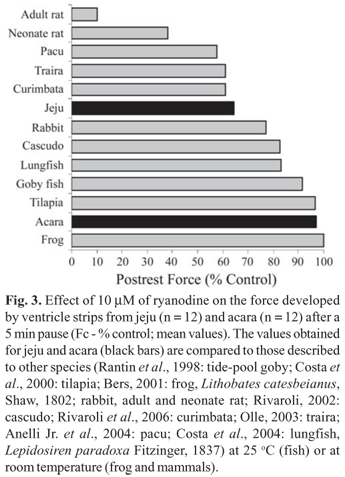This study analyzed the physiological role of the cardiac sarcoplasmic reticulum (SR) of two neotropical teleosts, the jeju, Hoplerythrinus unitaeniatus (Erythrinidae), and the acara, Geophagus brasiliensis (Cichlidae). While the in vivo heart frequency (fH - bpm) of acara (79.6 ± 6.6) was higher than that of the jeju (50.3 ± 2.7), the opposite was observed for the ventricular inotropism (Fc - mN/mm²) at 12 bpm (acara = 28.66 ± 1.86 vs. jeju = 36.09 ± 1.67). A 5 min diastolic pause resulted in a strong potentiation of Fc (≅ 90%) of strips from jeju, which was completely abolished by ryanodine. Ryanodine also resulted in a ≅ 20% decrease in the Fc developed by strips from jeju at both subphysiological (12 bpm) and physiological (in vivo) frequencies. However, this effect of ryanodine reducing the Fc from jeju was completely compensated by adrenaline increments (10-9 and 10-6 M). In contrast, strips from acara were irresponsive to ryanodine, irrespective of the stimulation frequency, and increases in adrenaline concentration (to 10-9 and 10-6 M) further increased Fc. These results reinforce the hypothesis of the functionality of the SR as a common trait in neotropical ostariophysian (as jeju), while in acanthopterygians (as acara) it seems to be functional mainly in 'athletic' species.
Excitation-contraction coupling; Ryanodine; Sarcoplasmic reticulum; Ventricle strips






